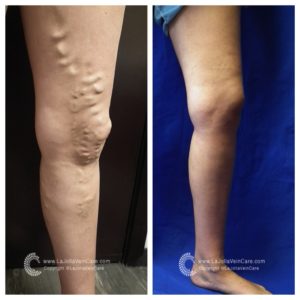Complications of Untreated Varicose Veins #1: Phlebitis
Web@ljvascular.com2021-11-04T15:28:12-07:00What Possible Complications Can Occur From Untreated Varicose Veins?
Over time, complications can develop from untreated veins. These include:
What Possible Complications Can Occur From Untreated Varicose Veins?
Over time, complications can develop from untreated veins. These include:

Before and After Photo: This is a before and after picture of varicose veins that were removed without surgery at La Jolla Vein Care. Modern varicose vein treatments no longer require surgical removal. Please see our photo gallery for more before and after pictures of varicose veins, […]
On Friday, former American Idol contestant Michael Johns suddenly died at age 35, allegedly from a blood clot that formed in his ankle. No official details have been released, but TMZ is reporting that Michael Johns twisted his ankle. Other celebrities who have made relatively recent headlines for suffering from DVT include Real Housewives of Atlanta star, […]
A thrombophlebitis is swelling and inflammation of a vein caused by a blood clot. There are two main types of thrombophlebitits: deep venous thrombosis (affects deeper, larger veins) and superficial thrombophlebitis (affects veins near the skin surface). This is often referred to as an STP.
The following symptoms are often associated with thrombophlebitis:
What is the difference between varicose veins and spider veins? Are they the same thing? Spider veins and varicose veins both refer to dysfunctional, dilated leg veins but the main difference is the size of the veins. Spider veins are small, thread-like veins at the surface of the skin. They often appear in clusters or […]
Venous duplex imaging uses ultrasound waves to create pictures. La Jolla Vein Care utilizes state-of-the-art ultrasound scanners to image the veins beneath the surface of the skin, not visible to the naked eye. Duplex ultrasound imaging can identify if the vein is healthy, or if it is refluxing, or if there are any blood clots […]

Venous […]

CONTACT INFORMATION
La Jolla/UTC
9850 Genesee Ave, Suite 410, La Jolla, CA 92037
Vista
906 Sycamore Ave, Suite 100, Vista, CA 92081
Use the search features below to find articles and insights for the diagnosis and treatment of vascular disease
CONTACT INFORMATION
9850 Genesee Ave, Suite 410, La Jolla, CA 92037
906 Sycamore Ave, Suite 100, Vista, CA 92081
Use the search features below to find articles and insights for the diagnosis and treatment of vascular disease